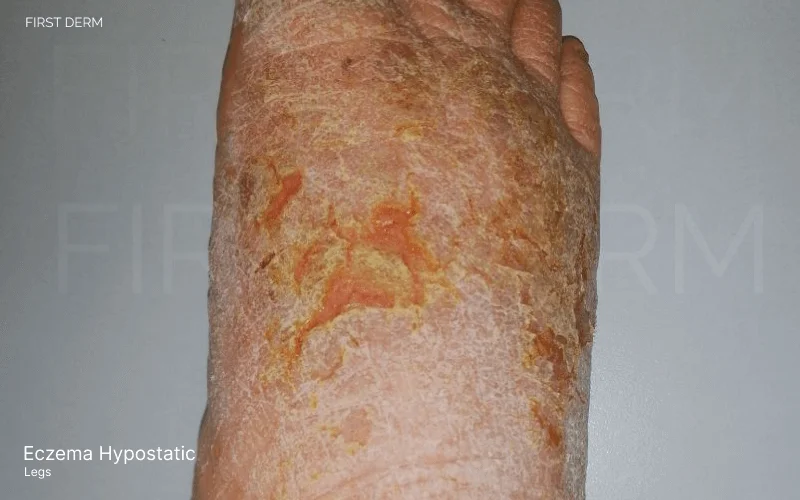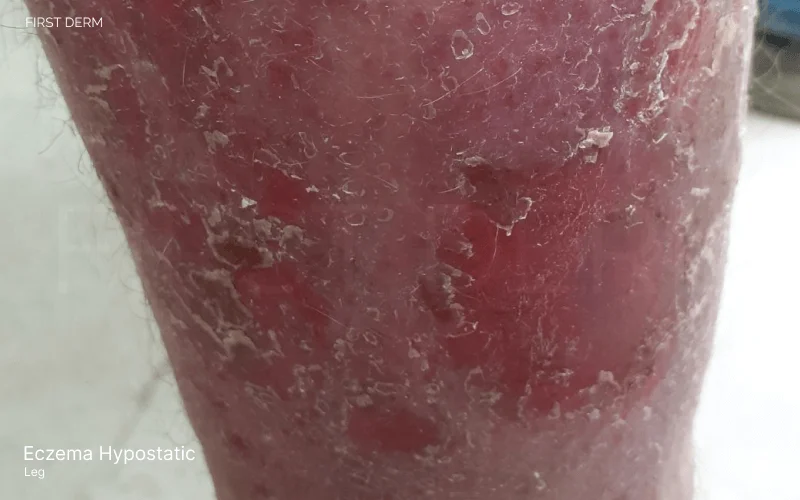Eczema Hypostatic
Medically reviewed by The Dermatologists and written by Dr. Alexander Börve
- What It Is: Venous eczema, or gravitational dermatitis, affects lower legs due to venous insufficiency.
- Who Gets It: Mostly middle-aged/older people, 20% over 70. Linked to deep vein issues, varicose veins.
- Causes: Fluid buildup, vein valve damage from clots or varicose veins, causing inflammation.
- Symptoms: Itchy, red, blistered, or dry and scaly skin patches. Orange-brown pigmentation, white scars, ‘champagne bottle’ leg shape.
- Complications: Secondary infections (impetiginisation, cellulitis), eczema spread, contact allergies.
- Diagnosis: Based on clinical signs, patch tests for allergies.
- Treatment: Reduce swelling (elevation, compression socks), manage eczema (drying patches, topical steroids, moisturizers), protect skin, treat varicose veins if necessary.
- Prevention: Avoid long standing/sitting, use compression wear, manage swelling, frequent emollient application.
- Outlook: Chronic condition, manage flare-ups promptly with steroids.
Eczema hypostatic is a type of eczematous rash you get most commonly in your legs. This condition is also known as venous eczema, varicose eczema, gravitational eczema, and stasis dermatitis.
People with abnormalities in the venous system (e.g. varicose veins, venous thrombosis) in lower limbs are more prone to develop this condition.[1] It has been found that 37−44% of patients who have leg ulcers can exhibit symptoms of venous eczema.[2] This itchy rash is not just about the discomfort—it can lead to serious complications if left unchecked.

Eczema Hypostatic on lower legs showing symptoms such as redness, scaling, weeping areas, and swelling, indicating severe skin inflammation
What is Eczema Hypostatic?
Hypostatic eczema typically arises due to poor circulation caused by venous insufficiency. This condition is characterized by symptoms such as redness, itching, scaling, and sometimes oozing of the skin in the affected areas.
Distinguishing Eczema Hypostatic from other types of eczema is essential for accurate diagnosis and treatment. While eczema in general refers to a group of inflammatory skin conditions, Eczema Hypostatic specifically occurs in areas predisposed to gravitational effects, such as the lower legs.
Hypostatic eczema can sometimes resemble early cellulitis, leading to initial rounds of antibiotics that don’t quite work. If you wear bandages soaked with oozing fluid for too long, it can irritate skin and give you contact dermatitis, which again can be misidentified as hypostatic eczema. While it will have sharp margins ending right where the bandage ends, hypostatic eczema will have vague margins.
Causes and Risk Factors: Eczema Hypostatic
Venous eczema serves as an indicator of venous disease, a condition that arises when the veins in a patient’s legs sustain damage due to factors elevating pressure in the venous system. According to national health service UK, several factors heighten the risk of its development:[3]
- Gender: Venous insufficiency is more frequently observed in females.
- Obesity: Excess weight can elevate pressure in leg veins.
- Pregnancy: Particularly in cases of multiple pregnancies.
- Family history: A genetic predisposition to venous insufficiency.
- Prolonged immobility: Remaining stationary for extended periods.
- History of deep vein thrombosis: Previous occurrences increase susceptibility.
- Advancing age: The likelihood increases with aging.
Venous insufficiency leading to eczema
Venous insufficiency sets the stage for the development of eczema hypostatic through a cascade of interconnected mechanisms. This vascular impairment often ends up in venous stasis, a condition where blood doesn’t flow well and pools in the legs. Here is how exactly it happens.
Healthy veins have valves that help blood flow towards the heart by opening in one direction and closing to prevent backflow. High blood pressure can damage these valves over time, causing them to fail. When one valve fails, it increases pressure on others, leading to a domino effect of valve damage. This stage is called venous insufficiency. This leads to further increased pressure in the veins, making it hard for blood to move against gravity and causing fluid to leak into surrounding tissues. Varicose eczema may result from the immune system reacting to this leaked fluid. Immune response triggers a series of inflammatory responses, disrupting the skin’s barrier function, leading to characteristic symptoms’ of gravitational eczema. Poor circulation compromises the delivery of oxygen and nutrients to the skin, leading to tissue damage and dysfunction. That is how complications like ulceration occur.


Eczema Hypostatic Symptoms and Diagnosis
Eczema is a clinical diagnosis, which means the clinician arrives at a diagnosis from the disease history and physical examination.[4] Therefore, proper knowledge of how the rash appears is very important.

Eczema hypostatic: dry skin with inflamed eczema characterized by red spots, scaling, weeping, crusting, and leg swelling
The skin in the affected area will appear red, itchy, and flaky, possibly even exuding fluids, forming crusts, or developing cracks. This condition typically affects both legs simultaneously.[5] In its initial stages, venous eczema manifests as a red and itchy rash with small clear blisters that may discharge fluid, and as it progresses to a chronic state, the skin becomes dry and scaly.[6] Burning and stinging sensations may also be felt which might occasionally extend beyond the rash.[7]
On lighter skin tones, it appears reddish or brownish, while on darker skin tones, it may appear dark brown, purple, or grey, which can sometimes make it more challenging to detect.[4] In cases of severe gravitational eczema, the skin may show erosion and appear as if it has numerous small ulcers.[7]
Eczema Hypostatic Treatment Options
There are two major aims of treatment: Eliminate persistent gravitational eczema and prevention of recurrance.[7] These goals can be achieved via a range of approaches:
Conservative Treatments
Lifestyle adjustments like elevating legs alongside compression therapy, are foundational as they can effectively manage venous hypertension, to alleviate persistent gravitational eczema and reduce the likelihood of its recurrence.
It’s crucial to recognize all topical products utilized by the patient, as certain self-treatments can be detrimental, such as the use of household antiseptics.
Direct exposure to irritants should be minimized. Typical irritants include extremes of temperature, alkaline or acidic substances, wool, and excessive moisture. To shield against the irritating effects of wool, the Wound Healing Research Unit recommends applying a layer of tubular gauze bandage.[7] Bandaging has the added benefit of protection against unconscious scratching, and ones that contain ichthammol, zinc or tar can give a soothing effect. Using a compression bandage initially, followed by an elastic stocking in the later stages is also found to be helpful.
Medications
Topical treatments, such as creams or ointments, offer relief. Consistent use of emollients creates a protective layer on the skin, guarding against dryness, irritants, and maceration from wound fluids, while also reducing scaling. Emollients should be applied regularly to the surrounding skin, following the direction of hair growth to minimize the risk of folliculitis. Preferably, all topical therapies should be in the form of ointments rather than creams, as studies have shown ointments to have a more potent and longer-lasting effect.[7]
Astringents like potassium permanganate can help alleviate the oozing associated with severe eczema and also possess some antibacterial properties. Treatment typically involves immersing the affected leg in a solution for 15–20 minutes or, if not feasible, applying gauze soaked in the solution.[7]
Topical steroids play a vital role in effectively managing severe gravitational eczema. Examples are, Triamcinolone 0.1% or Cutivate or another class II steroid topical applications.[8] It is important to continue their application for at least 2 weeks, as premature discontinuation often results in recurrence.[7] While each component alone may not be highly effective, when used together, their effects are significantly amplified.
Systemic therapy, like oral medications, may be considered for severe cases. Staphylococcus aureus is a bacterium that commonly inhabits and infects eczematous skin, exacerbating gravitational eczema through various means, including the release of exotoxins.[7] Therefore, antibiotics targeting S. aureus, such as flucloxacillin, play a crucial role in the management.
Advanced Treatments
Surgical interventions target underlying venous issues, addressing the root cause for long-term management. Vein Stripping can be done in an open vein surgery, where the affected veins are removed through small incisions.[10] Minimally invasive procedures such as endovenous laser ablation (EVLA) or radiofrequency ablation (RFA) are used to close off diseased veins using heat. Endovenous laser ablation method is proven effective to treat chronic venous insufficiency, leading to over 80% success rate at healing venous eczema within 6 months period.[9] Sclerotherapy is another procedure used, where a solution is injected into the affected veins to irritate the vein walls, causing them to collapse and eventually be reabsorbed by the body.[10]
Managing Complications and Preventing Flare-ups
Complications such as ulcerations and infections are common with Hypostatic Eczema. Monitoring for signs of ulceration, regular wound care and keeping the affected area clean and appropriately dressed are crucial steps to promote healing. Practicing good hygiene, avoiding scratching, and prompt treatment is necessary to keep infections at bay. To minimize complications and flare-ups, regularly moisturize with emollients to maintain skin hydration. Identify and avoid irritants like harsh soaps and detergents. Employ compression therapy with bandages or stockings consistently to improve circulation and reduce swelling. Make lifestyle modifications such as elevating legs, staying active, and managing weight. Ensure ongoing medical follow-up for timely interventions and treatment adjustments.
Conclusion
Eczema hypostasis, dry itchy red rash that is often a consequence of underlying venous insufficiency, can lead to a cascade of nasty complications if left untreated. But let’s remember that while it may present its challenges, there is always hope on the horizon. When healthcare professionals swiftly identify symptoms, they can kickstart interventions that ease discomfort, stave off flare-ups, and lower the chances of complications like ulcers and infections. This means brighter days ahead for those dealing with this condition, with proactive care paving the way for better skin health and overall well-being.
Source
- Feather A, Randall D, Waterhouse M, eds. Kumar and Clark’s Clinical Medicine, International Edition. 10th ed. Elsevier Health Sciences; 2021:662-663.
- Payne, D. (2023). Venous eczema: more than just a rash. British Journal of Community Nursing, 28(6), 298–300. https://doi.org/10.12968/BJCN.2023.28.6.298
- Varicose eczema. nhs.uk. Published October 19, 2017. Accessed April 21, 2024. https://www.nhs.uk/conditions/varicose-eczema/
- de Vries CJ, de Witt-de Jong AW, Dirven-Meijer PC, Burgers JS, Opstelten W. NHG-standaard ‘Eczeem’ [The Dutch College of General Practitioners practice guideline ‘Eczema’]. Ned Tijdschr Geneeskd. 2014;158:A8009.
- Nazarko L. Diagnosis and treatment of venous eczema. British Journal of Community Nursing. 2009;14(5):188-194. doi:https://doi.org/10.12968/bjcn.2009.14.5.42076
- Brown A. Managing skin conditions due to venous leg ulceration. Nursing and Residential Care. 2011;13(6):280-285. doi:https://doi.org/10.12968/nrec.2011.13.6.280
- Patel, GK; Llewellyn, M; Harding, KG . (2001). Managing gravitational eczema and allergic contact dermatitis. British Journal of Community Nursing, 6(8), 394–406. doi:10.12968/bjcn.2001.6.8.7056
- Eczema hypostaticum (hypostatisch eczeem). www-huidziekten-nl.translate.goog. Accessed April 15, 2024. https://www-huidziekten-nl.translate.goog/zakboek/dermatosen/etxt/EczemaHypostaticum.htm?_x_tr_sl=nl&_x_tr_tl=en&_x_tr_hl=en&_x_tr_pto=sc
- Starodubtsev V, Lukyanenko M, Karpenko A, Ignatenko P. Endovenous laser ablation in patients with severe primary chronic venous insufficiency. Int Angiol. 2017;36(4):368-374. doi:10.23736/S0392-9590.17.03779-8
- Lisii C, Heckenkamp J. Varikosis – aktuelle Therapiekonzepte [Varicosis-Current treatment concepts]. Chirurgie (Heidelb). 2024;95(5):415-426. doi:10.1007/s00104-024-02063-4
Ask a Dermatologist
Anonymous, fast and secure!

The Specialist doctor from the University Hospital in Gothenburg, alumnus UC Berkeley. My doctoral dissertation is about Digital Health and I have published 5 scientific articles in teledermatology and artificial intelligence and others.

